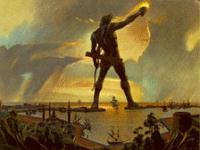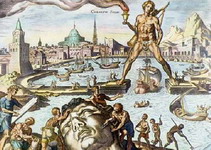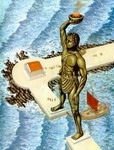The Colossus of Rhodes
The colossus of Rhodes was located in the wearing of Rhodes in Greece, probably at the end of the current Saint-Nicolas Day mole, where some marble blocks have been found and could have been used to build the base of the statue.The colossus of Rhodes was set up between 303 and 291 BC, so it took twelve years of hard work to totaly finish it.
Made of bronze and based on marble block, the statue was 32 meters (105 feet) heigh from the top of the head to the feets, that is to say 14 meters (46 feet) less than the statue of liberty in New York. The heigh enabled the statue to be visible by the ships approching to the port. In his raised arm, the sun god held a torch while his other arm was pressed on a lance. Contrary to the illustrations we usually find, ships were not passing under the colossesus's legs to enter in the wearing of Rhodes. It was technically impossible that the statue had its legs split.
The statue had been partialy destroyed in 225 BC after a earthquake. Then, in 653 AC, all the material (more than 13 tons of bronze and nearly 7 tons of iron, according to Philon) is taken by an arab expedition to be sold to a jewish merchant of Ephesea. The statue has been raised at the entry of the port for only 65 years
Why is this a wonder of the ancient world ?
We can say that the colossus of Rhodes is part of the seven wonders because of its exemplary vastness. Moreover, it should well be realized that this Greek monument is the result of a very hudge technical prowess which is characterized, amongst other things, by the use of terra cotta moulds necessary to the casting of the colossus. According to the legend, Charas of Lindos commited a suicide when he discovered an error in his calculs, error that one of his assistants had to correct.
illustrations :




